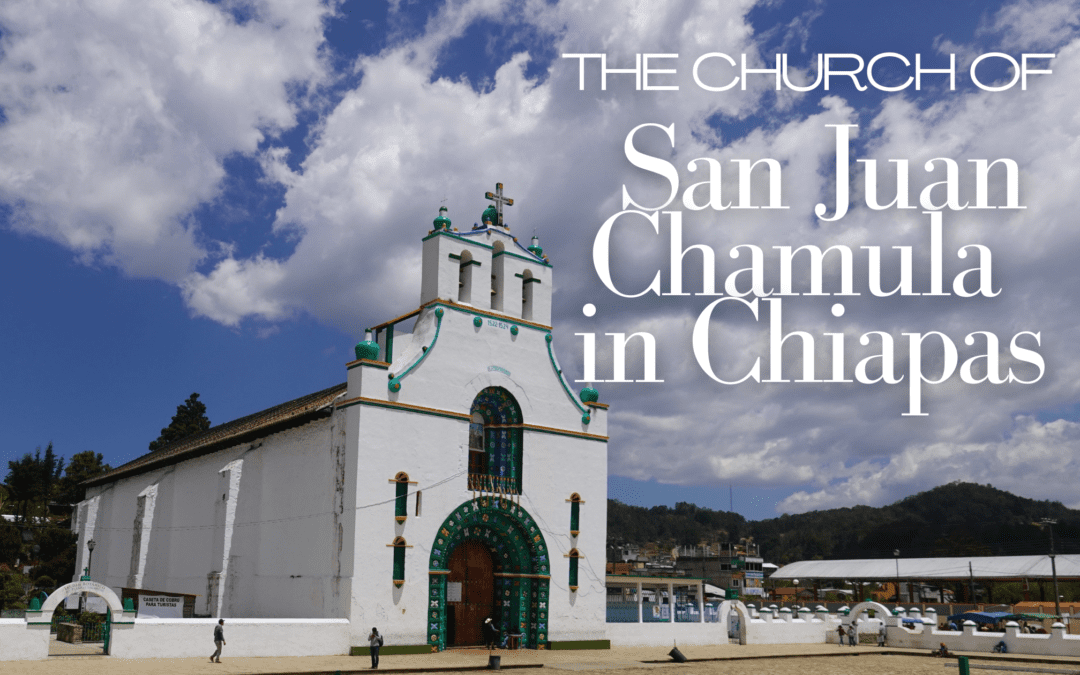
Getting there from San Cristobol de las Casas
Chamula is a town and municipality that is entirely run by the local Mayan people who have lived there for centuries. This was long before the Spanish came along and conquered the area (in nearby San Cristóbal de Las Casas). Chamula is a 20-minute drive outside of SCDLC. You will wind through a green, mountainous landscape on your way there. You may also notice the Tzotzil Maya people tending to their sheep along the side of the road and up into the mountain sides. The women wear black sheep wool skirts wrapped around their bodies with beautiful woven huipils as their tops.
Our Guide Felix

Entering the town we met up with our guide who we had hired through airbnb experiences named Felix. He was a small, soft-spoken man, not Mayan but of local heritage. As we began to talk we found that he had a profound and obvious love for the Tzotzil Maya people, culture and language. We discovered that he had learned much of the Tzotzil Maya language – a distinct dialect, as there are around 30 dialects of the Maya language. These dialects range from areas in southern Mexico down throughout all of Guatemala, Belize and parts of northern Honduras. He also told us he was in the midst of creating an app to help preserve and learn Tzotzil Mayan.


To Be One-Hearted
We started out in the cemetery as he explained to us the Tzotzil Maya’s belief in the meaning of life, the afterlife and the way of living expressed around different expressions of the “heart.” One expression that stuck out to us was “chap’ax -k’o’ol” which means two hearts and “Hun Co on Ton” which means one heart. The belief is that you should only ever do anything with one heart because with two hearts you are split and you are not fully present or happy with what you are doing. So you should never go into anything with two hearts or force anyone, including your children to go do anything if they have two hearts about it because something bad could happen. It is better to only do it if your heart is fully “in.” What a beautiful reminder this was! Be present. Be one hearted.


No Photography Rule
Then we made it to the little market with the church directly in front of us. We bought some fruit and made friends with a little family as we smiled and conversed a little.
We made it to the front of the church. Before going in Felix warned us that we should not pull out our cameras or take pictures under any circumstance inside the church. It is strictly forbidden. In fact we had heard stories of people who had done so and either had their camera confiscated, broken, had to pay a very large fine in order to get it back or in worst case scenarios thrown in the local jail for a day.


Back Story of a Autonomous Town
To add some context and backstory to Chamula one must realize the vast 500 year history of multiple rebellions and revolutions taking place in this mysterious, misty and mountainous landscape. To this day it is the most highly concentrated town of indigenous people all still speaking their indigenous Tzotzil Maya language (99%). It is also completely autonomous from the Mexican federal government. These Tzotzil Mayas have battled and fought off Spanish conquistadors, Catholicism (though they technically have a catholic church it is not really part of the Vatican and runs by its own rules), and the Mexican government. Police and federales are routinely kicked out of the town and it is entirely run by the indigenous Maya people dwelling there. What an incredible feat that is.
There is a decade-long waiting list of local Tzotzil Maya to be the annual spiritual leader of the famed church. This is no small undertaking. In order to become the annual spiritual leader one must commit to not only regularly cleaning the church, but also providing all of the candles and replacement of the pine needles on the floor every two weeks, as well as liquor (fact check) and food needed for ceremonies. It costs around $10,000 USD for this spiritual leader to do his duties. The hierarchy and social status of a person living in Chamula is based on their position in the local brand of religion. It has evolved into a seamless mix of ancient Maya rites, rituals and beliefs meshed with Catholicism, and a prominence of Saint John the Baptist for which the church is named.


Going Inside the Church
The outside of the church looks like almost any other Catholic church in Mexico with its brightly white painted walls and dark green trim, there are also pretty colorful flowers painted throughout the facade. A few bells loom over the top before getting to the front entrance with giant wooden doors. Our guide Felix paid our entrance fee and we were once again told, absolutely no photography allowed. I hid our camera and phone safely inside our bag adhering to this strict rule. We suggest you under all circumstances resist the urge to pull out your phone and sneak a picture, it is just not worth it here.

The Atmosphere: Pine Needles and Smoke
The most striking thing we noticed as soon as we walked inside was the absence of pews, the thousands of pine needles covering the floor and an endless amount of tall thin candles all over the floor. The candles were also perched on any available surface including tables, and altars. It is very dim and a cloud of smoke from the candles and copal resin incense casts the entire place in an ethereal, magical, candlelit space.
The low but consistent hum of a strange and magical chanting in ancient tongue, Tzotzil Maya wrapped all around us as we quietly and solemnly walked around the entire giant room. Along the walls on both sides we looked at the saints in “normal” Catholic attire (robes etc), all holding a mirror or with a mirror hung around their necks. Their eerie faces solemnly stare at you as the faint reflection of your own face looks back at you through the small square mirrors.
Reflection and Mirrors
After talking to our guide and a few knowledgeable friends about it later, the mirrors not only ward off evil, but represent portals to the supernatural underworld. There is a belief that the use of cameras could interfere with this portal due to the mirror inside the camera. Additionally, we have heard that the Mayans believe that if their souls leave their body when they are praying, they will be reflected through the mirrors on the saints, and be able to return back to their body and to their rightful place. There is also no confessional or priest. The mirrors are there to remind the believers to have their own self-confessionals, seeing and knowing their own sins as they look at their reflection through the mirror.
Chants and Rituals
In tune with uniquely autonomous and entirely indigenous Maya run towns, the church has a completely different feeling than any other church we’ve ever been to. We decided to sit down cross legged in the middle of the pine needles thanks to the approval of our guide for a few moments. I closed my eyes again hearing the faint hum of dozens of chants swirling all around me. Even though it feels strange and foreign, some part of me felt the peace and healing existing in all of those prayers. The chants rose up like the smoke from the tall multi-colored candles on the pine needle covered floor.
As I open my eyes and look around, I saw huddles of small groups, all Tzotzil Maya in their traditional clothing. Looking a bit closer (while remaining respectful not to stare), I noticed in each small group an older person dressed in all white. Their eyes were closed as they were chanting and some of them rocking back and forth as if in a trance. Coke bottles filled with clear liquid as well as coke dotted the floor around the groups. One group had a live chicken in a plastic black bag, it’s head and feathers visibly peeking over the top. I remember the bit we heard about live sacrifice happening here.
Sacrifice
Inside I cringed a little as I turned my head before I saw anything, but I did hear the commotion of someone breaking a chicken’s neck. We calmly but quickly got up and excused ourselves from the main area to meet up with our guide toward the entrance. He told us about the sacrifices and how the disease or illness from the person is transferred to the chicken or egg. That is why it must be sacrificed. A little more research into the subject explained similarly that any evil energies or sins are passed into the chicken and released from the human “patient” as the chicken dies and the shaman or curandero performs the sacrificial offering.

We later learned that the clear drinks in the coca-cola bottles was “pox,” or a highly alcoholic moonshine-type liquor made from corn, sugar cane and wheat and used for the ceremonies. The liquor creates a passage from the regular world into the supernatural world more easily. However coca cola was introduced at some point in recent past, in order to avoid drunkenness and create the same effect as evil energies are supposedly expelled during burping.
Syncretism
As far as the multi-colored candles, each color serves a certain purpose and can call onto a specific deity or god. Each saint (there are dozens in the church), also supposedly mask or embody a deity or god from the ancient Maya religion. It was a way for the Catholic church to be able to gain a hold with the fiercely rebellious Maya people living here who did not for obvious reasons want to give up their way of life or their religious beliefs and rituals. Therefore a merging of the Catholic religion superimposed over the existing Maya religion was permitted. It is utterly apparent here to this day and is something that seems so seamless and natural, yet completely unique.

After the tour of the church, we walked across the street from the main square in front of the church, to a little building which is a store and houses everything needed for ceremonies in the church. We saw a huge supplies of candles, as well as bottle upon bottle of “pox.” At the counter our guide Felix, by this time feeling like our friend, ordered three rounds of “shots” for us. We took a sip of the “muy fuerte” pox and remarked at how fiery yet smooth the drink tasted. We laughed and enjoyed the drink however felt a bit strange about it since it wasn’t for a ceremonial purpose that we were drinking.
Our Advice
Our tour with Felix was such an interesting and fascinating one. We would highly recommend hiring a tour guide which there are plenty of them running out of SCDLC however we couldn’t recommend Felix enough. He is both serious, sincere, soft spoken, kind and fun all at once, and his love for the Tzotzil Maya, with all of their incredible culture, beliefs and way of life made this tour so spellbinding and meaningful for us. We left feeling a lot more connected and in awe of this incredible town and the people who live there and continue to hold strong to their culture and way of life. It was an honor to learn from Felix!









Thanks for sharing.
Your very welcome!!
Very nice write up. I haven’t been to Chamula since 1986, but what you’re saying rings true. I hope to go next month. Just FYI, the 23 “dialects of Maya” are actually > 23 separate languages, many of which themselves have regional dialects. They derive from “Proto-Mayan” which is thousands of years old. Similar languages can be used to trace migration across southern Mexico and Central America.